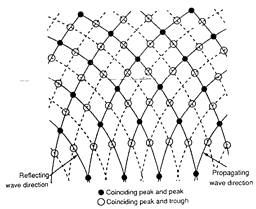 |
Science Frontiers ONLINE No. 69: May-Jun 1990 |
|
|
A Clash Of Hypotheses
Millions of Mima Mounds dot various terrains west of the Mississippi, from British Columbia south to northern Sonora, Mexico. They are also found in Africa and South America. Mima Mounds are formed of soil and small stones. They are often 2 meters high, with diameters of 20 meters. Mound densities can reach 25-50 per hectare. Mima Mounds, prai-rie mounds, pimple mounds, or whatever they are called locally, are widely thought to be the work of pocket gophers, although this hypothesis is still contested, as we shall see below.
No one denies that pocket gophers are often associated with the mounds. In fact, a recent scientific paper describes the relationship between the sizes and shapes of the mounds and the numbers of resident gophers. The authors of this paper, G.W. Cox and J. Hunt, state confidently that:
 The seismic waves intersect, an interference pattern forms. Loose surface material collects at points of minimum surface disturbance (open circles). |
"Investigations of Mima mounds in western North America support the hypothesis that mounds are formed by the gradual translocation of soil by pocket gophers..."(Cox, George W., and Hunt, Jodee; "Form of Mima Mounds in Relation to Occupancy by Pocket Gophers," Journal of Mammalogy, 71:90, 1990.)
In another paper, appearing at almost the same time, A.W. Berg contends that the Mima Mounds could instead be the consequence of seismic activity. In his abstract he says:
"Small-scale Mima mounds can be produced experimentally by subjecting a plywood board covered with a thin veneer of loess to impacts that produce vibrations in the board. Experimentally produced mounds have characteristics that are nearly identical to those found in the field. This suggests that most Mima mounds formed as the result of seismic activity in conjunction with unconsolidated fine sediments on a relatively rigid planar substratum."
Berg also notes that the regions where the mounds are common have been seismically active.
(Berg, Andrew W.; "Formation of Mima Mounds: A Seismic Hypothesis," Geology, 18:281, 1990. Cr. J. Satkoski)
Reference. Mima mounds are discussed on more detail in ETM1 in the catalog: Carolina Bays, Mima Mounds. Details on this book here.